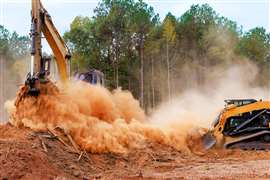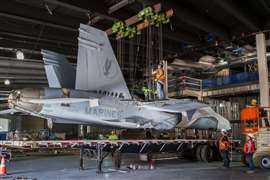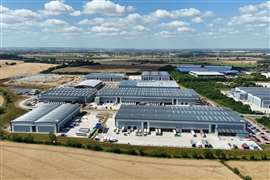Catching up with gypsum
12 March 2008
According to Dave Marsh, WRAP's material recycling project manager, there are two obvious main sources for plasterboard waste – installation (off-cuts and damaged boards) and removal during refurbishment or demolition. Precise figures are hard to obtain, but Mr Marsh told D&Ri that he estimates that 300,000 tonnes is generated during the former operation, with another 600,000 tonnes coming from the latter. With additional materials coming from other sources, it is therefore reasonable to estimate that every year close to 1 million tonnes of gypsum product waste is generated in the UK alone, although he was at pains to point out that there is a rather large possible margin of error to these figures.
Interestingly, it is WRAP's view that most if not all of this material is readily recyclable to the point where the resultant product can be used in a variety of applications, from incorporation into the plasterboard production process, unfired clay block production, cement manufacture and numerous others.
However, despite this, the vast majority of the UK's plasterboard waste ends updumped in landfills. Mr Marsh estimates that there is currently around 500,000 tonnes of recycling capacity available on an annual basis in the UK, but that throughput is only around 250,000 tonnes, i.e. a recycling rate of only 25% and a substantial unused capacity. “There is a long way to go,” he said, “lets put it that way.”
Given the UK demolition industry's recent (and not so recent) track record of relatively high recycling rates for the more readily recyclable products, this figure has to be a disappointment. So why is the rate so low?
Hurdles to overcome
There are three main barriers to the recycling of plasterboard waste. The first is cultural: “There is still a perception that collecting plasterboard waste for recycling is not feasible or is too costly – this is not true and WRAP is currently conducting a lot of work to overcome this barrier,” said Mr Marsh.
The message that the organisation is trying to get over to the construction industry is that while disposal may appear to be the cheap option, this is actually not the case. What is often not taken into account is the costs involved over and above the cost of hiring a waste container – the value of the material being thrown away, the labour required to handle it, the cost of landfill etc.
Overall, the true cost of disposal could be up to 10-15 times the hire cost of the waste container and the cost is increasing, with the UK's landfill tax now being ramped up year on year. Currently it stands at £24 (US$50) per ton, rising to £32 (US$66) next year and by 2011 it will be £48 (US$100).
The second barrier is related to on-site working. “Often, those actually working the site are not engaged in high-level policies of reducing waste to landfill, often as a result of poor communication.” Frequently a site often will have a waste segregation system in place but unless site workers can see a good reason to follow the scheme there is very little incentive for them to follow it, with waste therefore ending up in the nearest container.
WRAP is therefore working on good practice guidance for on-site works and encouraging companies to communicate this through to its site employees.
The third barrier is one of lack of infrastructure. Plasterboard recycling is still at a relatively immature stage. There are only a few recycling facilities for this material type and as a result, frequently the material has to be carried considerable distances from the site, imposing greater costs and creating transport issues. WRAP has initiated two capital competitions targeted assisting the development of the required infrastructure. “Building up the infrastructure will make the transport of plasterboard waste more easy and more cost-effective,” said Mr Marsh.
Currently, there are two main routes for recycled materials – a take-back scheme operated by plasterboard manufacturers with certain contractors (but this only applies to new plasterboard waste from construction projects) and a handful of independent recycling centres around the country. WRAP's capital scheme is aimed at increasing the number of these independents, as well as enhancing the capabilitiee of existing facilities.
Contamination concerns
Contamination is a big issue when it comes to recycling plasterboard but not perhaps in the way readers might think. In this instance, contamination is taken to mean when the waste reaching the recycling centre contains too much other debris such as wood, metal, plastics etc. In this event, it is possible the recycling centre might reject the whole load and return it to the site whence it came, or sort it themselves and pass the cost of doing so on to the sender, or even possibly dispose of the waste to landfill with the initial consignee again bearing the cost.
Waste plasterboard from demolition activities has in the past been perceived as being more likely to be contaminated with other materials as above, and this perhaps one reason why a greater percentage of waste material from this source is not being currently recycled by demolition contractors. Plasterboard recyclers have initially been targeting the waste from new construction, since it is generally perceived as being cleaner and freer from contamination by other materials.
However, contamination issues can relatively easily be addressed by following a good material segregation regime on site, even where waste from demolltion operations is concemed. As Mr Marsh says: “If you have a plasterboard waste container that is a third full of metal studding, then the odds are there is also a scrap metal stockpile/container on site, and you are loosing the potential scrap value of that metal studding. Good site practices would see the metal studding being place in the appropriate place, rather than with the plasterboard.”
Another obvious point is to keep the waste plasterboard dry – plasterboard is very good at taking up any available moisture, so any container should be well covered to prevent the ingress of moisture. “In one study, we discovered that a plasterboard waste container left uncovered overnight gained 10% in weight and that increase in weight instantly goes on the disposal coast.” said Mr Marsh.
The actual process to produce a quality end product has to be carried out in quite a controlled way, using equipment that is simllar to standard crushers, tuned and set up to match the requirements of plasterboard. According to Mr Marsh: “It could be feasible to do it on site, but at the moment the route we would encourage people to follow would be to undertake recycling in a purpose designed facility. There are shredders being marketed to process plasterboard on site but the problem I see is that the material they produce is in a form that is not readily reusable on site.”
Some of the work that WRAP is currently engaged In is looking at the use of recycled gypsum products in this way, for construction road bases and other similar applications but this is using gypsum produced in a dedicated facility and the reuse of material processed on site has yet to be addressed.
Chipping away
From the early days of WRAP's plasterboard process, it had always been aware of the fact that when plasterboard is removed during demolition or refurbishment, the pieces were invariably quite large and when these are placed in a waste container, a large number of voids result. This is not the most efficient way of handling waste, since the result is a lot of volume but not a lot of weight, which in turn means greater transport being required for a given weight of waste.
“This was an area we felt we ought to address,” said Mr Marsh. “Taylor Woodrow undertook a trial on our behalf and identified a plasterboard chipper that was under development that cut waste plasterboard into small pieces, rather than a shredding process.“ The result is that more material could be placed into waste containers. The trials conducted by Taylor Woodrow demonstrated that using such a chipper could deliver considerable savings on site, in terms of labour costs and also carbon savings.




